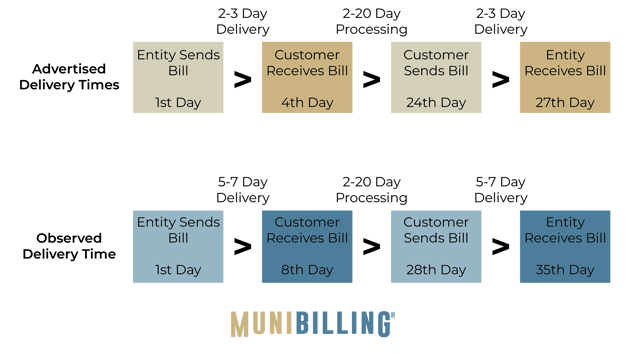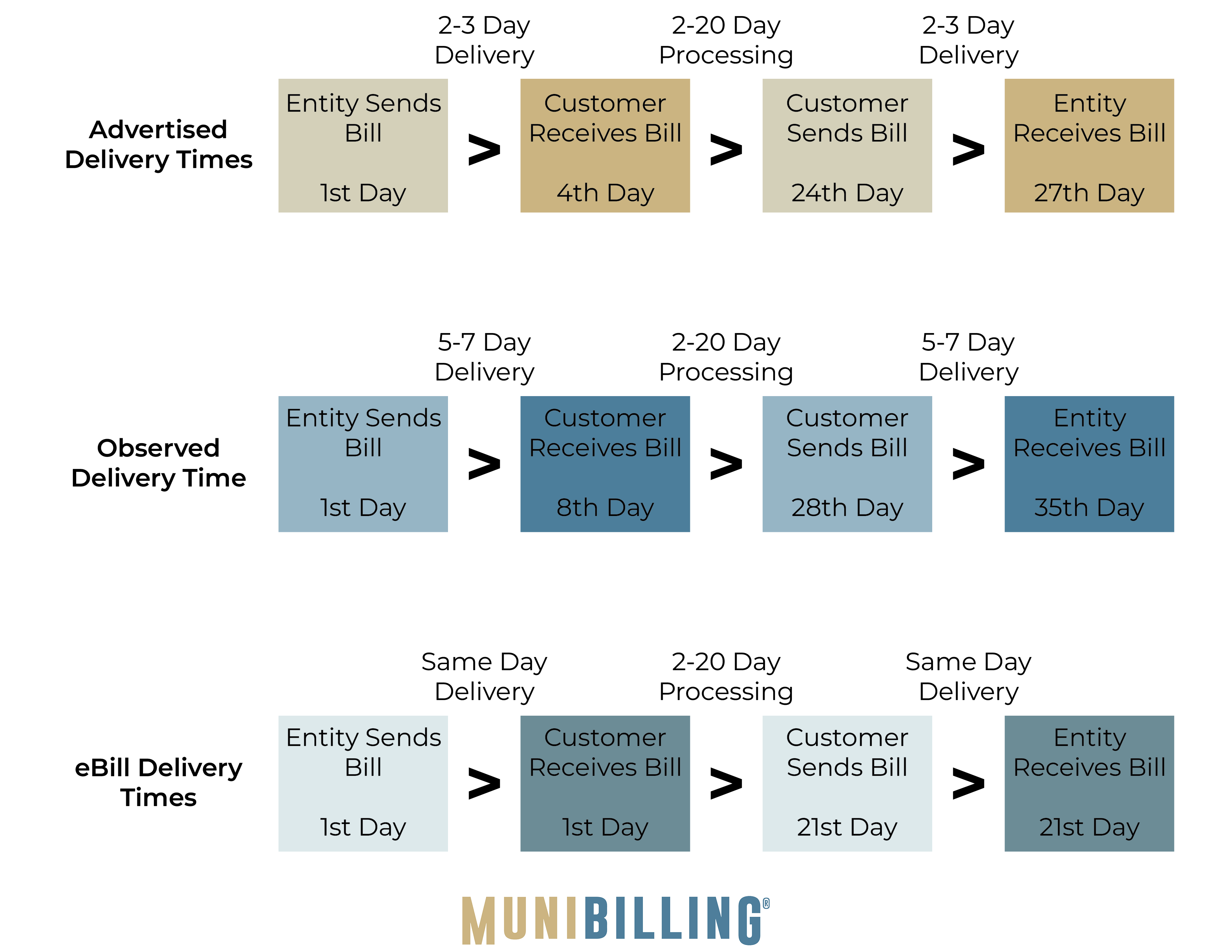Need help?
Please email us at support@munibilling.com or call us at 1-800-259-7020
What The Latest USPS Changes Mean For Utility Billing Providers

But now costs are increasing and that is hitting all billing entities' bottom line, especially those who bill for utilities. Not only does it cost more, it's taking almost double the amount of time for bills to be received to your customers.
Dive into what exactly is happening with the United States Postal Service and what this means for YOU.
But if you have been relying on the United States Postal Service alone, then you may be feeling the sting of their increased costs and slower processes.
With the impact of the 2020 COVID pandemic, increase in parcel deliveries from online retailers, the great resignation, and inflation… postal costs are increasing, and that trend looks like it will be continuing.
Additionally, On April 2nd, 2022, the United States Postal Service (USPS) filed for a price increase that took effect on July 10th, 2022. This inflation on the USPS services derives from the Delivering for America plan, which was created to remove the USPS from their negative financial deficit.
- Letters (1oz) - $0.55
- Letters (Every additional ounce) - $0.15
- Flat/ Large Envelop (1oz) - $1.00
- Flat/ Large Envelop (Every additional ounce) - $0.15
- Postcards - $0.35
And here's the breakdown of costs now in 2022 due to the recent inflation:
- Letters (1oz) - $0.57
- Letters (Every additional ounce) - $0.24
- Flat/ Large Envelop (1oz) - $1.20
- Flat/ Large Envelop (Every additional ounce) - $0.24
- Postcards - $0.44
And it's understandable why they're increasing costs! The USPS has enacted these changes to help offset its multiBillion-dollar deficit.
While these changes may have little impact on larger businesses, the USPS is estimating that this will have a greater impact on smaller businesses and individual customers.
What Does This Mean For My Organization?
First and foremost, this change in the USPS's functionality means an instant increase of cost for your organization... But how much?
At first glance the price difference from 2019 to 2022 seems a bit menial in comparison, with only a $0.02 increase in cost. But multiply that cost out by ALL of your customers and that $0.02 increase hits the bottom line a little deeper.
If your organization were to mail out bills now it would cost you $0.57 for each bill, which now totals out to $3,420. This means you've incurred a monthly increase of $110 just to mail out bills. And so, this means a yearly increase of $1,320 on top of already paper-thin margins.
Now, think about any additional notices you have to send out to customers outside of regular billing cycles. Here's a brief list of some notices:
- Move-In Notices
- Late Fee Notices
- Disconnect Notices
- Move Out Notices
- Final Bill Notices
For some of these notices it's not just one additional piece of mail, but several depending on what needs to be communicated to your customers or how fast they respond to your notices. (Which depending on the situation could be very last-minute!)
Mentally start crunching these numbers, considering how much your organization handles these notices, and that yearly increase of $1,320 can greatly increase even further.
The Current Delay With USPS First-Class Mail's Impact To Delivery Rates
On top of the cost of postage, the USPS has been in the news a lot lately due to changes to its delivery schedule as well.
One of the most common services that USPS offers is first-class mail delivery. This service is often used to send invoices and bills to customers. Unfortunately, the USPS has announced changes to this service that could impact the delivery speed of YOUR bills.
The USPS had stated that it will begin to experience delays in the delivery of first-class mail back in 2019. However, over the years these delays have worsened into 2020, 2021, and will likely continue to worsen in 2022.

This could scarily enough cause a significant impact to your organization.
The delays are expected to be caused by a combination of factors, including a shrinking workforce, increased package volume, and aging infrastructure. Remember how we mentioned that the digital age was really starting to take over snail mail?
To address their financial issues, the Postal Service plans to reduce its workforce by around 220,000 employees over the next several years.
If your organizations rely on first-class mail to send out your utility bills, then you should begin to plan for these delays to counteract them as best as possible.
What Can My Organization Do To Avoid Late Deliveries On Our Bills?
The easy answer is that you shouldn't mail out your bills!
.... It's a bit of a joke, but not fully. See, with the digital era of the world really starting to consume most aspects around us, the smartest solution is to adapt and grow alongside it.
We understand though, that making that leap is not necessarily easy for everyone.That's why you'll have to take into consideration your organization, your team, and your customers to resolve this issue.
Below are a few viable options for any organization to consider.
1. Digital Bills
Let's start with the basics! Does your organization have the capability to email bills to your customers?
The need to mail utility bills has stemmed from a system being put into place prior to the introduction of modern technology. This has caused the main source of billing to still revolve around the USPS mailing system.
Almost ALL of your customers have email! With a customer email you can save a piece of mail by digitally emailing their utility bill, and any notices, to said email.
90% of Americans over the age of 15 use their own email. (Sourced by 99Firms)
Being a Utility Billing System provider, that handles territories across the United States, we understand that there are some locations that are so rural that your customer has unreliable access to broadband.
Without secure access to broadband, the option to digitally send bills becomes a bit more tricky. This doesn't necessarily mean the option to email bills is thrown out the window, but instead introduces a hybrid approach.
Divide up your bills by sending emails to those who have one and sending bills through the USPS for those who don't.
On top of that, you customers are already dealing with digital billing across other industries they deal with. Bills such as internet, phone, student loans, and more are all digital nowadays.
2. Customer Portal
Unfortunately, there are plenty of Utility Billing Systems out there that strictly deal with physical billing and payments. Making the idea of a powerful and intuitive online customer portal a secondary thought rather than a system priority.
Millions of consumers have switched over to paper-free billing options by going digital with their correspondence. This has caused a major shift in what the USPS has to deliver every day, but also what it'll cost to mail through them as well.
An online customer portal can be a great billing option for your customers though! (And we've got a blog on some of the more surprising benefits of a customer portal.) By providing a digital platform that can be a one-stop-shop for everything your customers will need.
Here are some benefits of an online customer portal:
- Customers can track all billing history digitally saved on the cloud
- Make paying online simple with only a few clicks to submit billing payments
- Easy to use interface that can help direct customers to where they need to go
By utilizing a customer portal, you won't have to worry about late deliveries on sent out bills or additional charges. The portal also allows your organization to RECEIVE the funds much quicker than having to wait for a physical check.

Removing the risk of having to penalize your customers for late payments, when maybe they sent out their payment almost 1-2 weeks prior!
However, we do understand that there can be a disconnect between you encouraging your customers to use an online portal and them actually following through on it. That's why we've written a blog on how to get you customers to use the online portal!
3. Customer Communications Strategies
Not every single notice your team sends out needs to be a whole separate piece of mail. In fact, your notices don't even need to be a physical piece of mail at all!
By utilizing a service to handle customer notifications your team can send out notices through, email, phone, or SMS to stay in touch with your customers. This also allows you to stay notified if they have opened and acknowledged the notification or not.
Set scheduled notifications that are impactful for your customers such as payment reminders or late notices
How would you notify your customers of a power outage or an emergency water shutoff? You can't exactly send out a boil notice via the mail...
Don't risk the safety of your customers when it comes to staying in contact with them.
Conclusion
With the ever-changing uncertainty behind the USPS, you shouldn't leave your organization stranded with late deliveries on your bills and increased rates.
Even more so, your organization should want to keep consistent contact with your customers. You are their only source of information when it comes to their utilities, so don't leave them stranded in their time of need.
